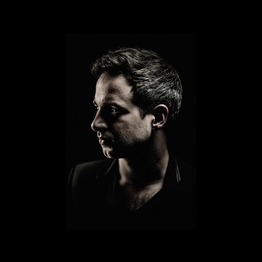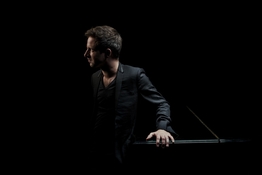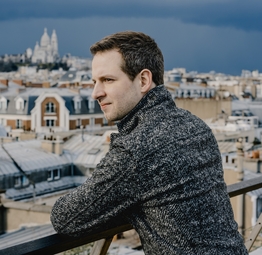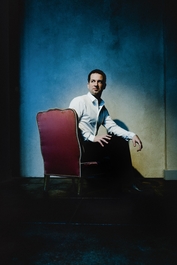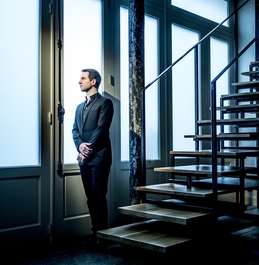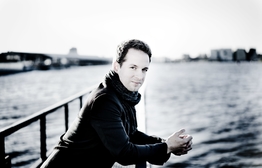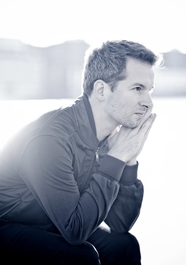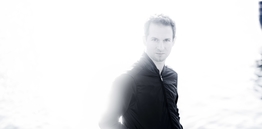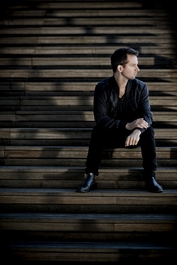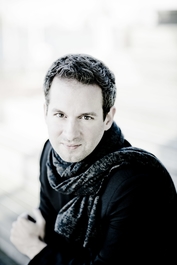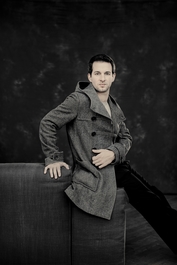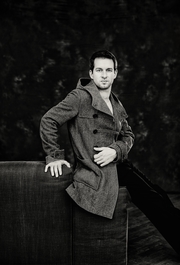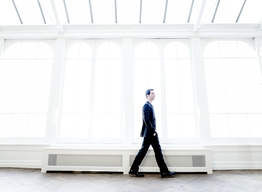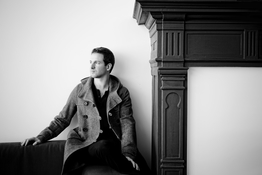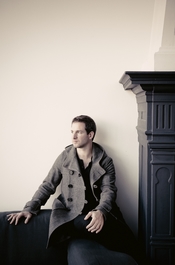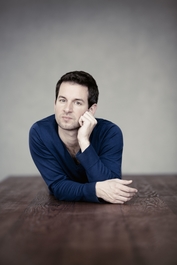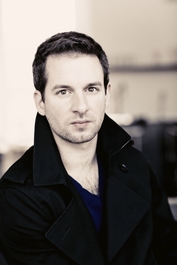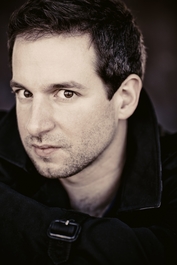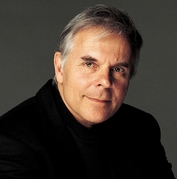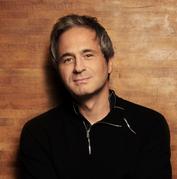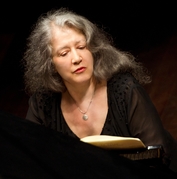Bertrand Chamayou
News
Vingt Regards sur L'Enfant-Jésus
Monumental, mystical and iridescent, Olivier Messiaen’s Vingt Regards sur L'Enfant-Jésus was composed, as Bertrand Chamayou explains, “at white heat” as the Occupation of Paris reached its end in 1944. Comprising 20 kaleidoscopic movements for solo piano and running for a total of two hours, it has captivated Chamayou since he first heard it as a child. For his recording of this landmark of the repertoire he has complemented its epic sequence of ‘gazes’ or ‘contemplations’ on the infant Jesus with five short musical tributes to Messiaen, written in the years following his death in 1992. They are by distinguished composers from five different countries: Toru Takemitsu, Tristan Murail, György Kurtág, Jonathan Harvey and Anthony Cheung.
“The work is a giant fresco, a kind of odyssey,” writes Chamayou, who first played the Vingt Regards sur L'Enfant-Jésus in 2008, the year that marked the centenary of Messiaen’s birth. “More than in any other of his works he harnesses the incomparable richness of his musical language, with its sacred roots, the influence of Gregorian chant, the soundworld of the organ and its stops, and moments where you hear carillons of bells. There are essential leitmotifs that run through the entire cycle … and surrounding these solid foundations is the manifold inspiration that constitutes the essence, the singularity of Messiaen’s style: birdsong, exotic music, his famous rhythms from Ancient Greece and Hindu culture, his shimmering harmonies which relate synaesthetically to colours of similar brilliance.”
Messiaen once wrote that "The drama of my life is that I have written religious music for an audience that has no faith." Bertrand Chamayou feels that a listener does not have to be religious to appreciate the Vingt Regards, even if its inspiration is explicitly Christian: figures from the Nativity gaze upon Jesus, as do the Star, the Cross and abstract entities such as silence, time and the spirit of joy; there are also evocations of sacred episodes, even of Christmas itself. “The cycle is a mystical rather than a religious experience,” says Chamayou. “It arouses the same kind of awe as walking into a magnificent cathedral or seeing a glorious sunset. You feel that time stops.”
Chamayou believes strongly that the set of 20 ‘regards’ is best appreciated as an unbroken cycle – “It comes out in a single flow and it doesn’t feel like two hours.” At the same time he understands that a listener who is new to the work might want to find a ‘way in’ through specific movements. He mentions No 15, Le baiser de l'Enfant-Jésus (The kiss of the Infant Jesus), which is a kind of extended lullaby; No 10, Regard de l'Esprit de joie (Contemplation of the joyful Spirit), a virtuosic, brilliantly colourful movement that he likens to a painting by Jackson Pollock; No 11, Première communion de la Vierge (The Virgin's first communion), “an atmospheric, meditative moment of repose at the heart of the work, though it also contains an episode with a sense of swing,” and the spectacular, explosive sixth movement, Par Lui tout a été fait (Through Him everything was made), which Messiaen himself compared to the cosmic Big Bang.
All in all, Chamayou sees Vingt Regards sur L'Enfant-Jésus as a work of universal relevance, and as the culmination of piano music in the first half of the 20th century, growing from the creativity of Debussy and Ravel, amalgamating late-Romanticism and Modernism, and inhabiting a very different world from the avant-garde of the post-War period, exemplified by composers such as Messiaen’s student Pierre Boulez.
Its effect on Chamayou himself has been profound. “I was very young, about nine years old, when I first looked at the score of the Vingt Regards and first heard it. This discovery had a determining impact on me. It was revelation and had a major influence on my development. Quite apart from the fact that I then spent time trying to compose in Messiaen’s style, I think I can say that the Vingt Regards, with their writing for the piano and their limitless imagination, have played a role in shaping the way I play, the sound I produce and my approach as an interpreter.”
Antonio Pappano conducts the Orchestra dell'Accademia Nazionale di Santa Cecilia in Richard Strauss’s Burleske and Ein Heldenleben
Antonio Pappano conducts the Orchestra dell'Accademia Nazionale di Santa Cecilia in two works from the earlier phase of Richard Strauss’s career: a comparative rarity, the Burleske for piano and orchestra, with Bertrand Chamayou as soloist, and the epic tone poem Ein Heldenleben, one of the composer’s orchestral masterpieces. Composed when Strauss was in his early twenties, the Burleske carries echoes of Brahms, Schumann and Liszt. Ein Heldenleben, premiered in 1899 when Strauss was 34, shows him at the spectacular peak of his early maturity.
Strauss’s first great operatic success was to come with Salome (his third opera) in 1905, but as Pappano – Santa Cecilia’s Music Director since 2005 – points out: “Strauss always thought dramaturgically. When you are recording his music in Italy, the link has to be through opera, with all its theatricality, temperament, contrast and colour. I think the cantabile, singing quality of this Roman orchestra matters a great deal, because Strauss was such a great melodist: you need a certain charisma in the sound, which these players achieve. When you look at score like Ein Heldenleben you might think it seems almost impossibly complex, but Strauss was incredibly sure-footed in the way he used the orchestra. It’s highly virtuosic. When everyone knows exactly what they are doing, the orchestral machine is really a wonder to behold.
“Ein Heldenleben – A Hero’s Life – is a fascinating piece. It’s strongly autobiographical. You get the feeling that Strauss is presenting himself as the hero.” It is not by chance that the hero’s theme is presented in the key of E flat – also the key of Beethoven’s ‘Eroica’ Symphony. “The score paints a complete picture of a human being… There’s his home life with his wife Pauline, who as ‘The Hero’s Companion’ is characterised by a solo violin played by Roberto Gonzales Monjas. As we can hear, Pauline could be both temperamental and sentimental. You almost feel like you are a voyeur on their marriage with its tensions, conflicts and reconciliations. But the piece is also about a man striving to achieve extraordinary heights, about our hero going into battle as he is attacked by critics, portrayed by cackling woodwinds.” In the section ‘The Hero’s Works of Peace’, Strauss quotes from his own works, including the tone poems Don Juan, Tod und Verklärung, Till Eulenspiegel and Also Sprach Zarathustra. “It’s as if he’s reliving his life,” says Pappano, “so that in the end he can say goodbye with calm and resigned positivity.”
Two years before his death in 1949, Strauss conducted a concert for the last time, at London’s Royal Albert Hall. The Burleske, written nearly 50 years earlier, was on the programme. Bertrand Chamayou feels it shares the mercurial spirit of Schumann’s Carnaval and Humoreske, as its title might suggest. “There is a sense of surprise – even the way it is fashioned in a single movement: it’s not really a concerto, though it lasts 20 minutes, and you never quite know where it’s going. Not only does it have a sense of humour, it has a sense of the absurd.”
Strauss originally conceived the Burleske for the pianist Hans von Bülow, a pupil (and son-in-law) of Liszt, who in 1875 had given the premiere of Tchaikovsky’s Piano Concerto No 1. Von Bülow found the Burleske excessively challenging in technical terms and dismissively refused to learn it. It was eventually premiered by Eugen d’Albert, another Liszt pupil. “Von Bülow, who had small hands, said it was impossible because the hand position had to change in every bar,” elucidates Chamayou. “It actually sometimes changes two or three times in each bar – your hands need to be as agile as a cat! Maybe this is all contributes to the element of surprise. The way composers wrote for the piano in the 20th century has accustomed us to technical demands of this kind, but the Burleske is still challenging for a modern pianist.
“Mozart saw a concerto as a dialogue between soloist and orchestra, but by the time we reach Brahms it has become more like a sinfonia concertante.” (Like Brahms’s mighty Piano Concerto No 1, the Burleske is in D minor.) “There is something Lisztian about the spirit and form of the Burleske too. Perhaps it is best described as a kind a symphonic poem with a soloist who is quite a hysterical character – maybe even a little crazy!”
Good Night!
The sixteen lullabies – or berceuses – that Bertrand Chamayou has chosen for Good Night! form a captivatingly varied album. Embracing music from the Romantic era to the present day, the French pianist has shaped his programme with care and imagination. Miniatures by masters like Chopin, Liszt, Grieg and Brahms (whose archetypal lullaby is heard here in Max Reger’s transcription) sit beside rarer treasures by, among others, Lyapunov, Alkan, Bonis and Lachenmann, and a specially commissioned piece by the contemporary composer Bryce Dessner. It makes a satisfying recital while providing individual items to enrich digital playlists.
“I’ve always loved the lullaby or berceuse as a genre because I’m an insomniac,” explains Bertrand Chamayou, who is also father to two young children. “There is that special moment as you are falling asleep – or not – and there are lots of things going on in your head. You experience all kinds of emotions, from comfort and reassurance to anxiety. The lullaby’s place is halfway between dream and reality.
“The piano repertoire has added lustre to the berceuse’s reputation, starting with Chopin, and I’ve always harboured the idea of dedicating an album to the genre. I think what finally encouraged me to turn that dream into a reality was becoming a father and not being able to find any lullaby playlists on digital platforms that really had something to say.” In addition to the composers already mentioned, this stylistically and culturally diverse album contains lullabies by Balakirev, Busoni, Janáček, Martinů (Chamayou ascribes a nightmarish quality to his ‘Ukolébavka’) and Villa-Lobos.
“I had played some of these pieces,” continues Chamayou, “but some of them were new discoveries I made while putting this project together. Once the concept for this album was clear in my head, I did a lot of research, which revealed some real musical jewels. A huge number of lullabies have been written for the piano, and my initial list was long enough to fill at least three albums! I hope, of course, that all the pieces will interest listeners, but there will be some discoveries – like the piece by Liapunov, the little berceuse that Liszt wrote at the end of his life – a long-standing favourite of mine – and another by the female composer Mel Bonis.”
Introducing the brand new piece on the album, Song for Octave by Bryce Dessner, Chamayou says: “Having made a selection of lullabies from the 19th and 20th centuries, I thought that we really ought to have one from the 21st century, and it seemed obvious to get a piece specially written. As the selection already included a superb atonal lullaby from the 1960s, Helmut Lachenmann’s Wiegenmusik, I thought it would be a good idea to commission a composer whose idiom is more melodic and ‘harmonious’. I immediately thought of Bryce Dessner, who is a friend of mine and who has a young son called Octave.
“I heard Bryce’s superb concerto for two pianos, which was premiered in France by Katia and Marielle Labèque and the Orchestre de Paris in 2018, and it seemed to me that the slow movement of that concerto inhabited the right world for the new lullaby. Bryce’s style is typically post-minimalist, using elements of the repetitive musical style of Steve Reich or Philip Glass, but in a less strict or theoretical way, incorporating the style in a freer musical narrative. His talent shines out, whether in his ‘classical’ compositions, his film music or his work with his rock band, The National. He is unique in both his personality and in what he does and I am very happy to have this world premiere on the album.”
When conceiving Good Night! Chamayou was at pains to create an album that would make sense as a whole. “My only worry at the start of this project was that a whole album of lullabies would be too uniform in tone. Even if each piece could be listened to separately – especially with the way streamed music works – it was still important for me to think of this as an album, to tell a story by putting the pieces in a defined order. I wanted the pieces to express subtly different feelings, and as I researched the repertoire I was reassured by the variety of pieces on offer … Each composer expresses something genuinely different in each of these lullabies, but there is also a universal resonance in each emotion the pieces evoke. It really does all correspond to the different states we experience as we drift between consciousness and unconsciousness. Damien Quintard, the sound engineer for this recording, told me at the end of the sessions that he didn’t think he’d ever recorded such a varied album!”
Good Night! was recorded using Dolby Atmos technology, which produces ‘three-dimensional’ immersive sound when played through compatible speakers. “You feel as if you are being enveloped by sound,” says Chamayou, who also explains that the ambience was subtly varied for each piece on the album, reflecting its particular realm of senses and emotions.
Bertrand Chamayou to release Saint-Saëns concerto and solo piano album
On the eve of his Proms debut in London 20 July, Bertrand Chamayou unveils the cover of his forthcoming album, featuring two concertos and solo piano works by Saint-Saëns.
Although best-known today for the delightful Carnival of the Animals, the rollicking Danse Macabre and the majestic Organ Symphony, the French composer Camille Saint-Saëns (1835-1921) was one of the greatest piano prodigies of the 19th century, composing five concertos for the instrument, alongside a body of solo works including 18 Études. Though rarely heard or recorded today, the latter are by turn charming, brilliant and fiendishly difficult, calling to mind the thrilling technical feats in the etudes of Liszt, who described his younger colleague as ‘foremost among French composers’.
It is one of today’s greatest French virtuosos, Bertrand Chamayou, who has taken up the pianistic challenge, presenting the composer as a true original hiding behind staunchly Romantic tradition. ‘I’m always charmed by Saint-Saëns,’ says Chamayou. ‘There’s an attraction to the exotic, the bizarre, sensual fantasy, that’s very curious for a composer that we think of as so academic. And there’s a real sense of voyage in the music of Saint-Saëns that I find fascinating.’
Chamayou’s thoughtfully constructed programme draws together the two most famous of Saint-Saëns’s five piano concertos – the epic No.2 (1868) and the irresistibly exotic No.5 ‘The Egyptian’ (1896) – alongside a bouquet of lesser-known solo piano works. He is joined by the Orchestre National de France and its formidable conductor Emmanuel Krivine for an album that promises fireworks, champagne and just a few puffs of opium.
The Second and Fifth concertos were composed almost 30 years apart, moving from what Chamayou describes as the ‘poignant, theatrical’ grandeur of the 2nd Concerto’s opening Bach homage, mounting in speed and excitement for a blistering Tarantella finale, to the Egyptian’s sun-drenched, sparkling rhapsody and the exotic harmonies of the atmospheric second movement of a concerto that the well-travelled Frenchman completed in Cairo.
The seven etudes and virtuoso miniatures for solo piano that conclude the album are a rare delight for pianophiles. They include the effervescent yet notoriously difficult Étude en forme de Valse with its breathtaking bravura finale, and the entrancing Les Cloches de Las Palmas inspired by the bells Saint-Saëns heard ringing out in the Canary Islands. ‘There’s a very flamboyant Lisztian side, but at the same time the luminous clarity and translucent technique of Mozart,’ Chamayou explains.
On this album, Chamayou not only masters the intricacies of every finger technique in the composer-pianist’s arsenal, but voyages beyond the notes to reveal Saint-Saëns’s sensitive side. ‘The Étude for Major and Minor Thirds is so nostalgic and melancholy; he has the capacity to evoke so much in just four pages,’ he says. ‘I wonder why he didn’t open his heart like this more often. He would be better known today, but it’s now up to the performer to choose the pieces that shine light on the genius of this composer.’
Saint-Saëns Piano Concertos and solo works with the Orchestre National de France and Emmanuel Krivine, out 7 September. Pre-order here.
2018 BBC Proms line-up revealed: Joyce DiDonato, Jean Rondeau and more!
The BBC Proms has revealed its 2018 programme, with several French classical stars making their Proms debut.
On 5 September, Joyce DiDonato reprises the role of Dido in highlights from Berlioz's Les Troyens, this time with John Eliot Gardiner and his Orchestre Révolutionnaire et Romantique. The American mezzo's recent recording with the Orchestre Philharmonique de Strasbourg and maestro John Nelson won the BBC Music Magazine Award for Best Opera Album earlier this month.
French coloratura soprano Sabine Devieilhe will take to the Royal Albert Hall stage for the first time on 26 July in Debussy's sensual cantata La Damoiselle élue, marking the centenary of the French composer's death. She sings Debussy on her latest album of French arias and songs, Mirages.
In another important French debut, Romantic pianist extraordinaire Bertrand Chamayou plays Mendelssohn's First Concerto on 20 July, with the BBC National Orchestra of Wales.
At Cadogan Hall, on 23 July, Jean Rondeau: another Frenchman in another Proms debut, this time an all-French harpsichord recital including music by Royer (from his album Vertigo), François Couperin and a world-premiere by Eve Risser.
Violinist Renaud Capuçon was in London recently for the launch of his Bartók concertos album with the London Symphony Orchestra. He returns 19 August with the Orchestre de la Suisse Romande as soloist in an orchestration of the Ravel Violin Sonata in G Major.
Soprano Diana Damrau sings her heartland repertory, songs by Richard Strauss, with the Royal Liverpool Philharmonic Orchestra and Vasily Petrenko.
A conductor very much familiar to London audiences, Sir Antonio Pappano, brings his Italian Orchestra dell'Accadamia Nazionale di Santa Cecilia to town for Bernstein's Symphony No.1 marking the centenary of the American composer's birth in August. Pappano has recorded the complete Bernstein Symphonies and The Age of Anxiety with the same orchestra and pianist Beatrice Rana for release later this year.
Discover the complete 2018 BBC Proms line-up here.
'Les Troyens' and Debussy Chamber Music win at the BBC Music Magazine Awards
The BBC Music Magazine Awards took place today in a ceremony at Kings Place in London.
In the Opera category, the winner is Berlioz's Les Troyens: the milestone 4CD opera recording on Warner Classics with an all-star cast headed by Joyce DiDonato, Marie-Nicole Lemieux, Michael Spyres and Marianne Crebassa, with the Orchestre Philharmonic de Strasbourg and maestro John Nelson.
The Chamber Music Album of the Year award went to the critically-acclaimed Debussy Chamber Music album on Erato, featuring pianist Bertrand Chamayou, violinist Renaud Capuçon, cellist Edgar Moreau, Emmanuel Pahud (flute), Gérard Caussé (viola) and Marie-Pierre Langlamet (harp). Bertrand Chamayou accepted the trophy on behalf of his colleagues, and played Clair de lune solo at the ceremony to celebrate the Debussy centenary year.
Congratulations to all this year's winners, who can be found in the May issue of BBC Music Magazine.
Vote now and have your say in the BBC Music Magazine Awards!
The shortlists for the 13th annual BBC Music Magazine Awards, the only classical music awards in which the main categories are voted for by the public, have been announced. A jury of expert critics selected this year’s 21 nominees across seven categories from over 200 longlisted recordings reviewed in 2017 by BBC Music Magazine, the world’s best-selling classical music monthly. The public vote is now open at the magazine’s website.
The many distinguished and varied nominees include, in the Opera category, the epic recording of Les Troyens, hailed the new reference recording and topping many Best of 2017 lists including The New York Times, The Guardian and the Chicago Tribune, thanks to its impressive orchestral and choral forces and an all-star cast headed by Joyce DiDonato, Marie-Nicole Lemieux, Michael Spyres and Marianne Crebassa.
'[Conductor John] Nelson drives the drama with unforced tempos but ample theatrical vitality. Spyres...sings with lyrical grace and spirit...Joyce DiDonato sings Dido with characteristic security and expressiveness,' opined BBC Music Magazine in its five-star review.
Flying the French flag in the Chamber category is the sensational team featuring Renaud Capuçon (violin), Edgar Moreau (cello), Emmanuel Pahud (flute) and Bertrand Chamayou (piano) in these mercurial Debussy sonatas - charming one moment, sensual the next. The French critics called the six players a 'supergroup', while BBC Music Magazine noted that 'a sense of joy in collegial music-making pervades these performances. Unlike many, violinist Renaud Capuçon and pianist Bertrand Chamayou and their colleagues do not avoid the vein of sensual passion that glows beneath Debussy's perfectionism...Perhaps the finest all is the beautiful balance of elegiac tone that thins out of the Sonata for Flute Viola and Harp.'
The Concerto category also features French harpsichord firebrand Jean Rondeau on the album Dynastie, with intensely intimate, energised performances of concertos by Bach and sons. 'His spirited and eloquently ornamented playing serves the music of JS Bach and three of his sons uncommonly well,' declared BBC Music Magazine.
There are seven categories open to the public vote: Orchestral, Concerto, Opera, Choral, Vocal, Chamber and Instrumental. Audio excerpts are available on the voting site, and all UK voters will be entered into a draw to win copies of the nominations.
The winners of the Awards will be announced at a ceremony on 5 April at Kings Place, London. In addition to the public awards, there are four jury awards: Premiere Recording, Newcomer of the Year, DVD of the Year and Recording of the Year.
See all the nominees and have your say now!
Bertrand Chamayou on the cover of International Piano magazine
Bertrand Chamayou is the cover star for the January 2018 edition of International Piano magazine, out now. The in-depth interview delves into the mystery and spirituality of the music of Liszt, Debussy and Ravel.
'Bertrand Chamayou doesn’t just perform music of the great Late Romantic and French Impressionist composers – he seems to channel their very spirit as he plays. Robert Turnbull met the Frenchman at his International Piano Series debut in London, where he mesmerised the audience with some extraordinary Liszt.'
International Piano explores how Chamayou's recordings 'have become legendary, admired especially by France’s younger generation who see him as a successor to Jean-Yves Thibaudet.'
Chamayou also discusses the new Debussy Chamber Music album, which was named one of The Guardian's Top 10 Classical Albums in 2017.
Bertrand Chamayou triumphs in Elbphilharmonie debut with complete Ravel
The warm-up: a lunchtime concert for the workers at the famed Steinway factory in Hamburg. The main event: Bertrand Chamayou's sold-out debut in the north German city's already-iconic new concert hall, the Elbphilharmonie. The programme: the complete solo piano works of Maurice Ravel - more than two hours of sensual, intimate and breathtakingly virtuosic playing. The result: "a colossal and stupendous evening" (Hamburger Abendblatt), an outpouring of emotion and a richly-deserved standing ovation from the audience.
The French musician is henceforth known in Hamburg as the Langstreckenpianisten ('the long-distance pianist'), according to the Hamburger Abendblatt review:
"As the hours passed, listeners might be forgiven for feeling incessantly and easily inebriated from so much refined elegance and sensuality – it was if the piano itself was about to take flight...Such refined ease, every now and then taken skilfully to the edge of a diabetic shock, and controlled all along by Chamayou with literally playful ease.
"Of course, one could perhaps offer many of these works with a touch more bravura and in a more overtly virtuoso manner, but Chamayou does not need to rely on this kind of reproduction. In the pieces displaying smaller forms, he allows subtlety free rein, the resultant jocularity scintillating at times, and imbued with flashes of genius which granted him the pleasure of juggling informally with the musical material. Ravel’s special strength, i.e. the impressionist etherealness of his compositional ideas, was thus adamantly effective. The straightforward directness with which Chamayou communicated Pavane pour une infant défunte shed the usual veils of sadness and was treated with an almost cool ease of being. And not to forget the four major pinnacles of this repertoire, which still had to be scaled: that frighteningly difficult nightmare triptych Gaspard de la nuit, Miroirs, and the Valse nobles et sentimentales, the latter interpreted as refined Schubert epigones. And then, the final hurdle before the home stretch: the historicism of a baroque pastiche that is Le tombeau de Couperin.
"Each individual opus was effort enough. These pieces are just so technically demanding. And that Chamayou was still enough in condition for an encore, was remarkable, as he rounded of a colossal and stupendous evening."
Bertrand Chamayou's complete Ravel double-album is available here.
The 2016 Gramophone Awards shortlist has been revealed
The prestigious Gramophone Awards shortlist has been announced, showcasing the finest classical recordings over the past year, as chosen by the leading classical music magazine's critics and specialists.
Seventy-two recordings have been shortlisted across twelve categories. The top three recordings in each category will be revealed in next issue of the magazine, which goes on sale on August 12.
There are particularly strong contenders in the Vocal categories, with French soprano Sabine Devieilhe - noted by Gramophone for her "pure, sweet timbre and dazzling virtuosity" - up against the likes of Jonas Kaufmann and Max Emanuel Cencic for her multi-award-winning Mozart album The Weber Sisters (Recital category).
Fresh from singing David Bowie at the BBC Proms in London, French countertenor Philippe Jaroussky is in the running for another prize, this time as one of the cast-members in Il Pomo d'Oro's magnificent triple-album recording of the Handel opera Partenope, welcomed by Gramophone as “a landmark event”.
Joyce DiDonato is a strong candidate for the Solo Vocal category for her live double album from Wigmore Hall Joyce & Tony, with her esteemed recital partner Sir Antonio Pappano at the piano in everything from Italian arias to the Great American Songbook.
In Opera, Pappano's Verdi Aïda, the all-star triple album studio recording from Rome, is a clear frontrunner, with tenor Jonas Kaufmann as Rademes - he is nominated again in the same category for his Pagliacci. Gramophone declared soprano Anja Harteros "the most interesting Aïda on record since Callas"; both she and maestro Pappano have been nominated for the public-voted Artist of the Year.
Among the Instrumental selections, Bertrand Chamayou does his countryman Ravel proud in the complete works for solo piano on a double album.
The Concerto category sees young Norwegian violin virtuoso Vilde Frang holding her own alongside the likes of Janine Jansen, with the recent Gramophone Recording of the Month, her "urgently communicative" Britten and Korngold Violin Concertos.
The Chamber category sees two Erato string quartets nominated for two sublime releases: the French Quatuor Ebène for their Schubertalbum featuring baritone Matthias Goerne and cellist Gautier Capuçon, and the German Artemis Quartet's searing Brahms, their last recording with the late, lamented violist Friedemann Weigle, which cellist Eckart Runge sees as "imbued with a sense of warmth, immediacy, friendship and love that is interwoven with a more spiritual, timeless beauty”.
See the full shortlist of the 2016 Gramophone Award nominees here.
Related releases










Upcoming Concerts
Thursday
Friday
Saturday
Sunday
Tuesday

